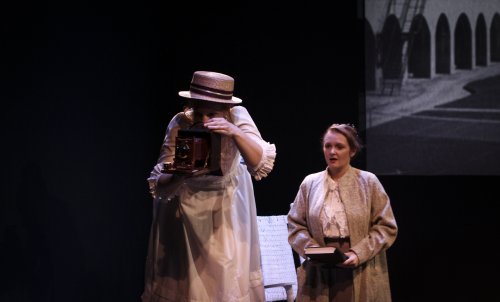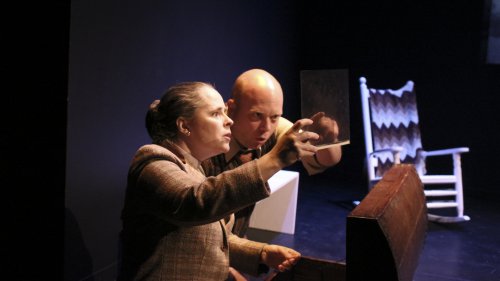Alice in Black and White
Intimate portrayal of Alice Austen -- an unconventional, daring, slice of life photographer who focused on “Street Types of New York” for over 40 years.

Jennifer Thalman Kepler as Alice Austen and Laura Ellis as Gertrude Tate in a scene from “Alice in Black and White” (Photo credit: Holly Stone)
[avatar user=”Cynthia Allen” size=”96″ align=”left” ] Cynthia Allen, Critic[/avatar]Alice In Black and White, by award-winning playwright Robin Rice, chronicles photographer Alice Austen’s controversial life and artistic development from 1876 — when she first was given a camera — until 1952, when she passed away. Not recognized as a pioneer in photojournalism until recently, historians and photography connoisseurs now are taking more notice of Alice Austen.
Kathi E.B. Ellis directs an uneven revival of the Looking for Lilith Theatre Company’s production of Alice in Black and White – a play which celebrates Alice Austen and her contributions to photography. It is timely that Austen is being commemorated in 2016 — the 150th anniversary of her birth.
Alice in Black and White is a play-within-a-play. Two parallel stories are told: one of Austen’s life and relationship with Gertrude Tate, her companion for over 40 years; and one in the early 1950’s involving a Staten Island Historical Society receptionist and journalist Oliver Jensen, who later published The Revolt of the American Woman (which included Austen photographs) and a Life magazine article on Austen.
Set in “the past (1876 – 1951),” the play takes place in and around Clear Comfort Farm, the Austen family home on Staten Island, and places to where Alice and Gertrude travel. Later “(1951 – 1952),” the story unfolds in and around the Staten Island Historical Society, the Staten Island Farm Colony, a nursing home and elsewhere.
Presenting a pre-teen Alice Austen adequately by an adult actor is often difficult, and Jennifer Thalman Kepler’s performance as a 10-year-old isn’t believable. But Kepler brings Austen’s adventurous spirit alive as an adult.

Trina Fisher and Joseph Hatfield in a scene from “Alice in Black and White” (Photo credit: Holly Stone)
There is a warm camaraderie between Kepler and Laura Ellis, who plays Gertrude Tate – Austen’s lifelong partner. As Oliver Jensen, Joseph Hatfield’s performance is over-the-top in conveying the all-consuming obsession the writer has in unearthing Alice Austen’s missing negatives. As Sally Lally, Trina Fischer is assured in her role as the Historical Society receptionist (cum aspiring “curator”), who has a puppy dog infatuation for Jensen.
From the get-go, Austen recorded a visual account of her native Staten Island social life during the Gilded Age. Austen’s look at society was not from a debutante point-of-view. Austen was a rebel and her rendition of subject matter many times included a sly sense of humor.
Paul Moakley, who curates shows at Clear Comfort — once Austen’s home, and now a museum — commented on Austen’s type of visual playfulness in a July 18, 2013 interview in the New York Times: “There is one picture of women in their underwear, with their hair down, smoking in a church rectory. It’s literally a photo of everything a Victorian woman shouldn’t be doing, all at once.”
Austen shot poignant photos of friends and family at home, in private clubs, on picnics, sailing, lounging by Staten Island estate seashores, and living the garden society life.
In the late 1890’s, Austen focused on Manhattan street life in grab your attention ways: newsboys, messenger boys, street sweepers, organ grinders, and peddlers, among others. These are the photos that gained her the most acclaim. In technique and subject matter, Austen anticipated the genre of documentary photography.

Jennifer Thalman Kepler as Alice Austen and Laura Ellis as Gertrude Tate in a scene from “Alice in Black and White” (Photo credit: Holly Stone)
However, little time is spent on Austen’s forays into New York City and “why” she decided to make such a long trek (almost a half-day’s journey at that time) to capture immigrant and other street life experiences. The “why” of going to Manhattan and who influenced her to photograph there, and not simply concentrate on a more easily accessible Staten Island, is left unanswered.
In structuring the play in two parallels worlds, Rice employs an interesting dramatic device. Oliver Jensen’s persistence in unearthing Austen’s work, and passion for writing about her significance, is key to bringing Austen’s photography back into the public eye. His book and Life article lead helped Austen be recognized as the first woman documentarian of photography. However, the back and forth between the two worlds is often confusing.
Many of Austen’s actual photos are used as wonderful, revolving backdrop projections on set designer Christé Lunsford’s walls, which greatly add to “knowing” how Austen viewed life. The costume designs by Lindsay Chamberlin aptly mimic the fashion shown in Austen’s background photos. Tom Willis (lighting design) punctuates the importance of particular characters and their actions. As both sound designer and composer, Nathan Roberts transitions the scenes through sound, segueing one scene to the next without interruption.
Alice in Black and White heralds Alice Austen’ important contributions as an artist, a woman and a photojournalist pioneer. Thanks to quick-thinking preservationists (including Oliver Jensen) and friends, more than 8,000 Alice Austen photos still exist as an extraordinary depiction of an era.
Writing about a woman, who was ahead of her time, but often viewed as out of place, Rice gives a much needed perspective on Austen’s complicated life choices and what sacrifices she made becoming America’s first female photo-journalist.
Austen used photography, not unlike people use cell phones today — spontaneously capturing the immediacy of the moment. However, whereas it took more than 75 years for Austen’s photographs to gain a modicum of recognition, Facebook, Instagram or Snapchat expedite photo celebrity today. Unlike Alice Austen, for some, fame may be just a click away.
Alice In Black and White (through August 14, 2016)
Looking for Lilith Theatre Company
59E59 Theaters.59 East 59th Street between Madison and Park Avenues, in Manhattan
For tickets, call Ticket Central at 212-279-4200 or visit http://www.59e59.org
Running time: two hours and 5 minutes including an intermission






Leave a comment